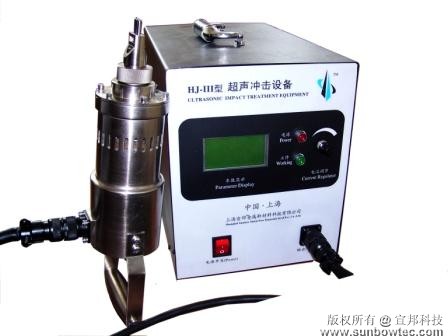Transfer from http://www.mfn.li/article/?id=882
In many instances, higher levels of compressive stresses than can be delivered through conventional shot peening are required. Additionally, the relief of tensile stress is required to deeper depths. A technology known as Ultrasonic Impact Technology (UIT) accommodates both of these requirements.
UIT is acknowledged as an advanced method for improving the physical properties of metals. UIT has aroused considerable interest in the area of fatigue, fracture and abrasion resistance. Its wide range of practical applications, repeatability and cost effectiveness also stimulate this interest.
Cracks are often generated at the surface, where imperfections provide ideal initiation sites, and where components are often most highly stressed. Crack initiation and subsequent propagation are retarded by compressive stresses which act normal to the crack plane. Conversely initiation and propagation are assisted by tensile stresses acting normal to the crack plane. Tensile residual stresses consequently reduce the fatigue life of the component, while compressive residual stresses increase fatigue life.
In welded structures, the magnitude of the tensile residual stress generated during welding has a direct and detrimental effect on the fatigue life.
The onset of fracture, either outright or after experiencing many cycles, is assisted by the presence of tensile residual stresses. UIT delivers compressive residual stresses at the surface, enhancing fatigue life and reducing the chance of fracture. These same compressive residual stresses are beneficial in preventing stress corrosion cracking.
On the surface UIT looks like peening, but it delivers so much more. Peening is a cold-work process which consists of impacting the surface of a component with either a tool or a high velocity particle stream. Under the force of each impact, the surface layer tries to expand laterally but is restrained from doing so by the elastically strained material that lies beneath it. As a result compressive residual stresses parallel to the surface are created which hinder crack growth, thus increasing the components?fatigue life.
Since plastic deformation is one of UIT effects, analogies between UIT and other conventional deformation treatment methods such as shot peening, hammer peening and ultrasonic shot peening have resulted. An experimental comparison of these and other methods has demonstrated that UIT is the most beneficial method. Measurement of compressive residual stresses clearly shows that UIT achieves much greater depth (roughly 0.020" for shot peening vs. 0.100" for UIT) correlating to greater life enhancement.
Typical results indicate that a UIT treated joint is twice as strong when compared to the peened samples. TIG dressed joints fared better than the peened joints but not as well as those enhanced with UIT.
UIT focuses on delivery benefit to key locations, avoiding treatment in surrounding areas. Traditional peening operations could be viewed as more of a global surface treatment and require media containment.
Residual stresses and geometric stress concentrations are the two largest factors affecting fatigue life. Customers see additional benefit of UIT replacing grinding as a fast consistent method of modifying the profile of the toe of a weld.
For general applications, UIT delivers:
*compressive residual stresses
*stress relief
*grain modification
*If used as a weld treatment UIT also modifies the weld toe geometry.
UIT interest and activity cover a wide range of industries, including: defense, aerospace, oil & gas, shipbuilding, ship repair, infrastructure, manufacturing, automotive and mining.

HJ-III Ultrasonic Impact Treatment
|
